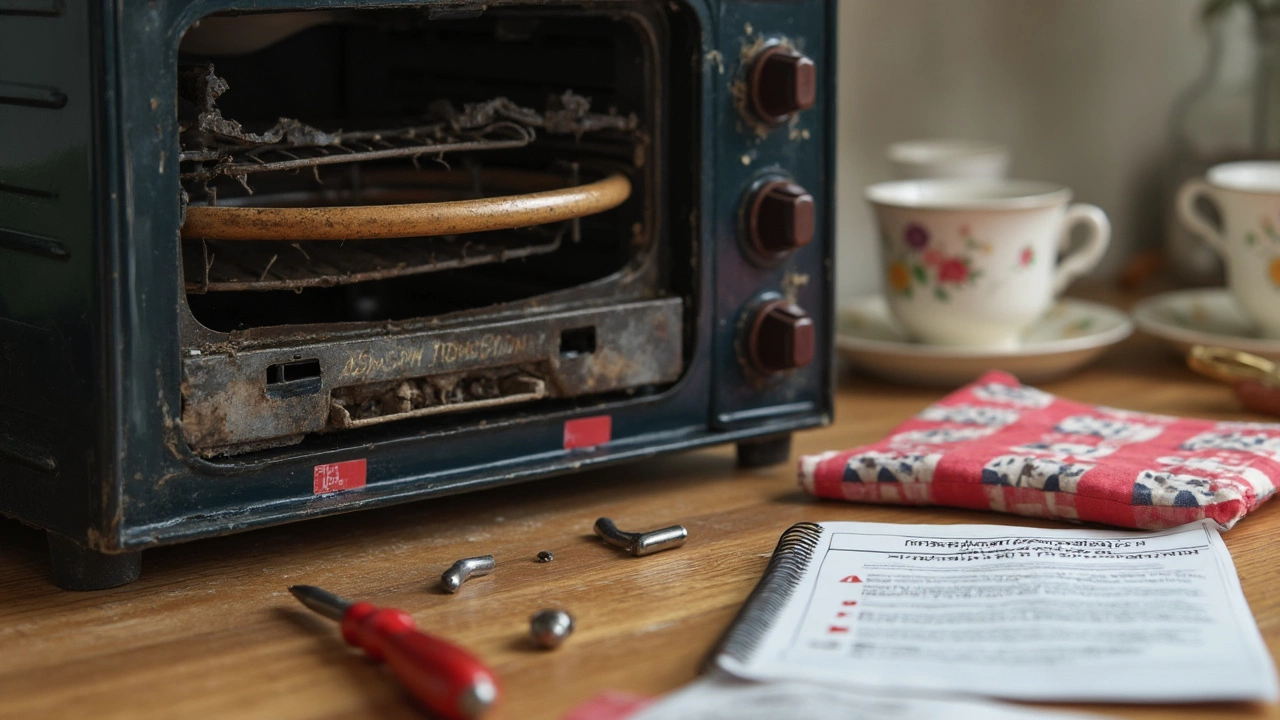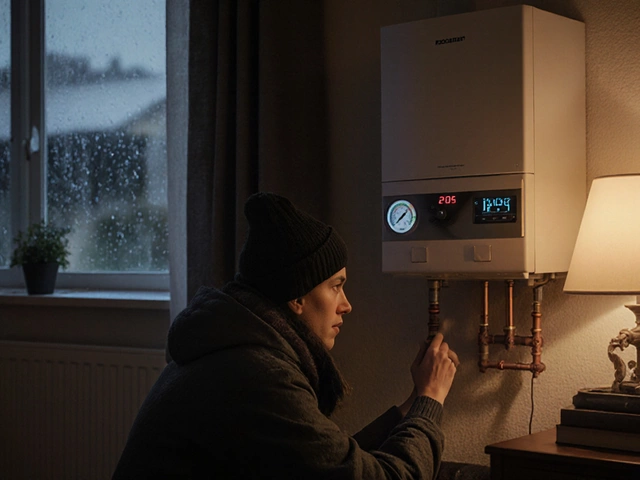Your oven’s heating element does all the heavy lifting. Once it goes out, most people are tempted to push their luck and keep using the appliance anyway. Here’s the deal: when an electric oven’s heating element is busted, you’re basically trying to bake a cake with a flashlight—it just isn’t going to do the job right, and you might make things worse.
The heating element is that thick, metal coil at the top or bottom of your oven—where the magic (or, well, the heat) happens. If it stops working, the oven can’t heat up like it should. Some people notice uneven cooking, food that never browns, or even just a cold oven. Others see sparks, smoke, or burn marks. Ignoring these signs is risky—not just for your casserole, but for your whole kitchen.
- What Does a Broken Heating Element Actually Do?
- How to Tell If Your Oven’s Element Is Toast
- What Happens If You Keep Using It?
- Is It Ever Safe to Use with a Broken Element?
- Temporary Fixes and Real Repairs
- When to Replace vs. Repair
What Does a Broken Heating Element Actually Do?
If you think of your electric oven as a team, the heating element is definitely the star player. It’s what gets hot and cooks your food. When it’s broken, the oven loses its main source of heat. That means—no surprise—your oven doesn’t get hot, or it heats up super unevenly. Ever try baking cookies and wonder why some are raw while a few end up burnt? That’s a classic sign something’s wrong with your heating element.
When the element fails completely, your oven might not turn on at all, even if the lights and display work fine. Sometimes, it half-works and can’t reach high temperatures. Other times, it only heats a tiny bit and gives up. If you keep forcing it, the broken piece can spark or even burn out your oven’s electrical system. In rare cases, this has caused small kitchen fires—big headache, right?
Here’s a quick look at what a broken element does to your oven:
- Food cooks unevenly or never fully cooks through.
- The oven never reaches the temperature you set.
- No response at all: the oven stays cold.
- Element gets discolored, develops holes, or looks burnt.
- Strange smells, smoke, or actual sparks come from inside.
For a quick comparison, check out this basic breakdown of a working vs. a broken element:
| Oven Element | What Happens |
|---|---|
| Intact & Working | Heats up fast, cooks food evenly, holds set temperature. |
| Cracked/Broken | Poor heating, cold spots, risk of sparks or electrical damage. |
So, if your oven repair isn’t on your to-do list yet, it probably should be. A broken element doesn’t just make dinner tricky, it can wreck the whole oven if left alone.
How to Tell If Your Oven’s Element Is Toast
Catching a busted heating element early can save you a headache. Most electric ovens show some pretty clear signs when things go south. First up: take a look. The heating element should look like a smooth, steady coil. If it’s got blisters, cracks, or noticeable breaks, that’s not normal—and it almost always means a replacement is needed.
When you turn on the oven, the working element glows bright orange or red. If yours stays dark, has only a few hot spots, or looks patchy, it’s probably cooked its last lasagna. Here’s a cheat sheet for what to check, right at home:
- Visual Damage: Are there burns, splits, or bubbles on the coil?
- No Heat: Does the oven stay cold even when you crank up the temperature?
- Uneven Cooking: Are cookies burnt on one side and raw on the other?
- Sparks or Smoke: Did you see sparks or smoke when you last used the oven?
- Discoloration: Has the element changed color or looks unusually faded?
You don’t need fancy tools to do a basic inspection. That said, if you’ve got a multimeter lying around, you can check for continuity. No reading? That element is officially kaput.
If you’re curious how common this problem really is, check this out:
| Heating Element Issue | Percentage of Electric Oven Repairs |
|---|---|
| Element fails to heat | 31% |
| Element visible damage | 17% |
| Element sparks/arcs | 9% |
If you spot any of these red flags—don’t ignore them. Using a broken electric oven just isn’t worth the risk.
What Happens If You Keep Using It?
If you keep running your electric oven with a broken heating element, get ready for trouble. The most immediate thing you'll notice—your food comes out half-baked, burnt in weird spots, or just never cooks through. That's if your oven even heats up at all. It’s not just an inconvenience—you’re losing control over how your food cooks, which is frustrating if you’re planning anything more ambitious than frozen pizza.
But here’s the bigger issue: safety. A busted heating element can short-circuit, meaning it might spark or even catch fire. According to appliance safety stats, faulty oven elements are a top reason for kitchen fires in the home. No one wants to turn dinner into a call to the fire department.
- Uneven or raw food, even if you crank up the temperature
- Broken elements can cause sparks or tripped breakers
- You risk electrical shock if you touch or clean around the damaged element
- Any weird smell—like burning electronics—means you should shut it down now
An electric oven repair isn't something to push off if you notice visible damage or weird performance. Still, people hope to use the broiler or another heating element as a workaround. Sometimes the broiler works, but you’ll get lopsided results and still risk damaging the rest of the oven. The cost of ignoring it? You might end up replacing more than just the element.
| Problem | Risk Level |
|---|---|
| Uneven Cooking | Low (ruined meals) |
| Electrical Sparks | High (fire hazard) |
| Busted Circuit Breaker | Medium (annoying, can damage wiring) |
| Burnt Smell or Smoke | High (immediate fire risk) |
Bottom line: once a heating element’s gone, don’t trust your oven to do what it’s supposed to do, let alone do it safely. Either repair it or leave it off until someone can take a look.

Is It Ever Safe to Use with a Broken Element?
Here’s the honest answer: using your electric oven with a broken heating element is pretty much never truly safe. When the coil is burnt out, cracked, or showing visible damage, it’s not just about losing out on heat—it’s about real safety risks.
First off, a damaged heating element can cause electrical shorts. That’s a fancy way of saying sparks can fly—literally. There are even reports of ovens smoking or tripping the circuit breaker. According to the Consumer Product Safety Commission (CPSC):
"Defective or exposed oven heating elements are a main cause of kitchen fires and electrical shocks when left unrepaired."
If the oven is only partially heating (for instance, just the broil or bake element isn’t working), you might get away with using it in a very limited way for a short period—like reheating leftovers with only one functioning element. But this is risky, and you’ll likely notice that the food cooks unevenly, or the oven might not reach proper temperatures. There’s also a real chance that the broken part could get worse quickly, leading to a complete shutdown or a fire hazard.
Here’s what can go wrong if you try to keep using it:
- Electric shock risk: Exposed wires or cracks in the element can shock you if touched, even lightly.
- Fire danger: Electrical shorts can spark a fire inside the oven.
- Ruined food: You’re likely to end up with meals that are burnt in spots and uncooked in others.
- Damage to oven: Using a broken oven may damage other parts, leading to pricier repairs later.
Check out these stats reported by the National Fire Protection Association (NFPA):
| Cause | % of Oven-Related Home Fires |
|---|---|
| Defective Heating Element | 43% |
| Lack of Maintenace/Repairs | 29% |
Bottom line? Any kind of broken oven, especially when it comes to the heating element, just isn’t something you should take chances with. A quick phone call to a repair tech is cheaper than a new kitchen—or a hospital visit.
Temporary Fixes and Real Repairs
So your electric oven heating element is shot. First off, there are no magic tricks to make a broken element work normally again. Tinfoil, tape, or sticking a pan over the busted element won’t bring back the heat. At best, you might get a few lukewarm meals. At worst, you may cause an electrical short or even a kitchen fire. If the element is cracked, blistered, or doesn’t glow red-orange when turned on, that’s a hard stop—don’t try to mess with it while powered on.
If you’re in a pinch and have a two-element oven (top and bottom), sometimes the remaining element will do the trick for certain foods. For example, broil-only cooking can work for open-faced sandwiches or melting cheese, but anything that needs even baking (cakes, bread, pizza) just ends up raw or burned in patches. Even then, uneven cooking is a real nuisance.
- Never use the oven if you see sparking, smell burning, or spot melted metal near the element. That’s just asking for trouble.
- Don't try to "jump start" the element by tapping or pushing it—modern ovens aren’t built to be fixed with a smack.
- If the oven has a convection setting, it won’t fix a dead element. The fan only moves air; it doesn’t create heat.
When it comes to repairs, here’s the straight path for most home cooks:
- Unplug the oven or turn off the breaker—electric ovens store a lot of power even when off.
- Remove the screws or clips holding the heating element in place. Most are at the back wall inside the oven.
- Pull the element forward gently. You’ll see wires attached with simple slide-off connectors.
- Order the correct part (use your oven’s model number—don’t just eyeball it).
- Slide new element connectors in, secure the screws, and turn the power back on.
If you’re not comfortable dealing with electricity or wiring, call a professional. Most oven repair jobs for heating elements are quick and cost about $100-$250, parts and labor included. Below is a handy table showing what you can expect when weighing temporary alternatives versus real repairs:
| Approach | Effectiveness | Risk | Cost |
|---|---|---|---|
| Tinfoil, makeshift fixes | Low/none | High (fire/electrical) | Cheap, but dangerous |
| Using only top/bottom element | Partial | Low/medium (uneven cooking) | None |
| Proper element replacement | Full | Safe | $30-$75 (DIY), $100-$250 (pro) |
Trying to get by with a broken element is more hassle than it’s worth. Real repairs are quick, and swapping in a new heating element fixes the problem for good. Don’t wait for something to spark or pop—get it sorted and get back to baking.
When to Replace vs. Repair
Deciding whether to repair or flat out replace your oven’s heating element depends on a couple of solid points. Most of the time, if only the heating element is broken and the rest of the appliance is in good shape, a simple replacement is the way to go. Heating elements aren’t crazy expensive—most range from $20 to $60 depending on your model—and you can usually swap one out yourself in under an hour.
But hold up before getting out the toolbox. If you spot more than one issue—like flickering oven lights, random shutoffs, or electrical smells—you could be dealing with deeper electrical problems, not just a burnt-out element. In that case, piling more money into repairs might not be worth it, especially if your electric oven is closing in on that 10-12 year lifetime mark.
If you’re still on the fence, check out this quick rundown:
- If your oven is less than eight years old and everything else works fine, repairing the broken oven usually makes sense.
- If your oven keeps having problems, or you’ve already replaced another part recently, this could be the sign to replace it.
- If you see scorch marks or melted spots in the oven cavity after an element blows, replacement is often safer.
Let’s put some numbers next to the decision. Here’s a comparison folks find handy:
| Fix | Estimated Cost (USD) | Time to Complete |
|---|---|---|
| Replace Heating Element | $20-60 (part), $80-200 (pro install) | 30-60 min |
| Repair Multiple Issues | $200-400+ | Varies |
| New Oven Purchase | $500-1,500+ | A week or more |
If the repair bill is more than half the price of a new oven—or if you’re worried your old unit is sucking up extra electricity—it’s probably time for an upgrade. Paying for repairs on an oven past its prime is like trying to fix a cracked phone screen for the fifth time. At some point, you just have to walk away.





